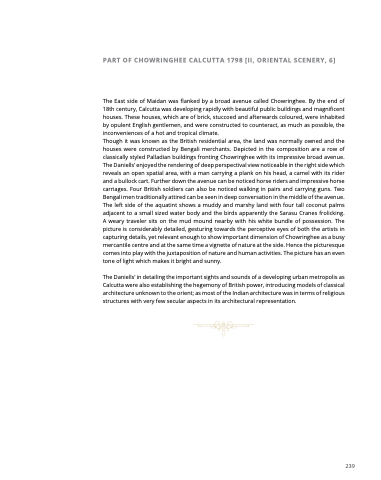Page 245 - Eye of the beholder
P. 245
PART OF CHOWRINGHEE CALCUTTA 1798 [II, ORIENTAL SCENERY, 6]
The East side of Maidan was flanked by a broad avenue called Chowringhee. By the end of 18th century, Calcutta was developing rapidly with beautiful public buildings and magnificent houses. These houses, which are of brick, stuccoed and afterwards coloured, were inhabited by opulent English gentlemen, and were constructed to counteract, as much as possible, the inconveniences of a hot and tropical climate.
Though it was known as the British residential area, the land was normally owned and the houses were constructed by Bengali merchants. Depicted in the composition are a row of classically styled Palladian buildings fronting Chowringhee with its impressive broad avenue. The Daniells’ enjoyed the rendering of deep perspectival view noticeable in the right side which reveals an open spatial area, with a man carrying a plank on his head, a camel with its rider and a bullock cart. Further down the avenue can be noticed horse riders and impressive horse carriages. Four British soldiers can also be noticed walking in pairs and carrying guns. Two Bengali men traditionally attired can be seen in deep conversation in the middle of the avenue. The left side of the aquatint shows a muddy and marshy land with four tall coconut palms adjacent to a small sized water body and the birds apparently the Sarasu Cranes frolicking. A weary traveler sits on the mud mound nearby with his white bundle of possession. The picture is considerably detailed, gesturing towards the perceptive eyes of both the artists in capturing details, yet relevant enough to show important dimension of Chowringhee as a busy mercantile centre and at the same time a vignette of nature at the side. Hence the picturesque comes into play with the juxtaposition of nature and human activities. The picture has an even tone of light which makes it bright and sunny.
The Daniells’ in detailing the important sights and sounds of a developing urban metropolis as Calcutta were also establishing the hegemony of British power, introducing models of classical architecture unknown to the orient; as most of the Indian architecture was in terms of religious structures with very few secular aspects in its architectural representation.
239


